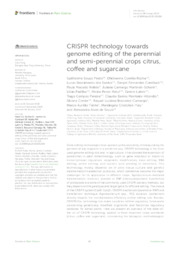CRISPR technology towards genome editing of the perennial and semi-perennial crops citrus, coffee and sugarcane.
CRISPR technology towards genome editing of the perennial and semi-perennial crops citrus, coffee and sugarcane.
Summary: Gene editing technologies have opened up the possibility of manipulating the genome of any organism in a predicted way. CRISPR technology is the most used genome editing tool and, in agriculture, it has allowed the expansion of possibilities in plant biotechnology, such as gene knockout or knock-in, transcriptional regulation, epigenetic modification, base editing, RNA editing, prime editing, and nucleic acid probing or detection. This technology mostly depends on in vitro tissue culture and genetic transformation/transfection protocols, which sometimes become the major challenges for its application in different crops. Agrobacterium-mediated transformation, biolistics, plasmid or RNP (ribonucleoprotein) transfection of protoplasts are some of the commonly used CRISPR delivery methods, but they depend on the genotype and target gene for efficient editing. The choice of the CRISPR system (Cas9, Cas12), CRISPR mechanism (plasmid or RNP) and transfection technique (Agrobacterium spp., PEG solution, lipofection) directly impacts the transformation efficiency and/or editing rate. Besides, CRISPR/Cas technology has made countries rethink regulatory frameworks concerning genetically modified organisms and flexibilize regulatory obstacles for edited plants. Here we present an overview of the state-of-the-art of CRISPR technology applied to three important crops worldwide (citrus, coffee and sugarcane), considering the biological, methodological, and regulatory aspects of its application. In addition, we provide perspectives on recently developed CRISPR tools and promising applications for each of these crops, thus highlighting the usefulness of gene editing to develop novel cultivars.
Publication year: 2023
Types of publication: Journal article
Unit: Embrapa Coffee
Keywords: Citrus, Coffee beans, Genome, Perennials, Sugarcane
Observation
Some of Embrapa's publications are published as ePub files. To read them, use or download one of the following free software options to your computer or mobile device. Android: Google Play Books; IOS: iBooks; Windows and Linux: Calibre.
Access other publications
Access the Agricultural Research Database (BDPA) to consult Embrapa's full library collection and records.
Visit Embrapa Bookstore to purchase books and other publications sold by Embrapa.

